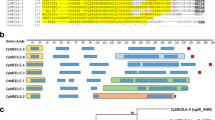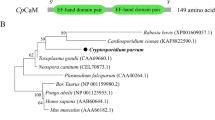Abstract
Cryptosporidium parvum is a zoonotic agent that bears a high risk for the health of particularly immunocompromised humans and animals. As currently available drugs and therapies against cryptosporidiosis do not turn out satisfactory, more intensive research on the control of this parasite is necessary. The genus Cryptosporidium is unique within the phylum Apicomplexa as its localisation is intracellular but extracytoplasmatic. Infection of host cells is initially a parasite-driven process, but the signalling events and their downstream actions within Cryptosporidium are poorly understood. Calcium-dependent protein kinases (CDPKs) are probably involved in the regulation of invasion and egress. Previously described in plants, algae and other Apicomplexa, CDPKs are not found in vertebrates. They are thus promising targets for pharmaceutical intervention. While CDPK1 is well characterised in Toxoplasma gondii (TgCDPK1) and Plasmodium falciparum (PfCDPK1), only little information exists about the expression and function of CDPK in C. parvum. Here, we describe results of the in silico analysis of seven CpCDPKs. Five CpCDPKs contain potential sites for N-myristoylation and N-palmitoylation. In a nested 3′ rapid amplification of cDNA ends (RACE)-PCR, expression of six CpCDPKs resulted in distinct bands in infected cell cultures and extracts of freshly excysted sporozoites. The length of the 3′ untranslated region (3′ UTR) is described as well. Our results indicate CDPK expression to be stage specific on the mRNA level.




Similar content being viewed by others
References
Abrahamsen MS, Templeton TJ, Enomoto S, Abrahante JE, Zhu G, Lancto CA, Deng M, Liu C, Widmer G, Tzipori S, Buck GA, Xu P, Bankier AT, Dear PH, Konfortov BA, Spriggs HF, Iyer L, Anantharaman V, Aravind L, Kapur V (2004) Complete genome sequence of the apicomplexan, Cryptosporidium parvum. Science 304:441–445
Barta JR, Thompson RC (2006) What is Cryptosporidium? Reappraising its biology and phylogenetic affinities. Trends Parasitol 22:463–468
Billker O, Lourido S, Sibley LD (2009) Calcium-dependent signaling and kinases in apicomplexan parasites. Cell Host Microbe 5:612–622
Bologna G, Yvon C, Duvaud S, Veuthey A (2004) N-Terminal myristoylation predictions by ensembles of neural networks. Proteomics 4:1626–1632
Carreno RA, Martin DS, Barta JR (1999) Cryptosporidium is more closely related to the gregarines than to coccidia as shown by phylogenetic analysis of apicomplexan parasites inferred using small-subunit ribosomal RNA gene sequences. Parasitol Res 85:899–904
Carruthers VB, Giddings OK, Sibley LD (1999) Secretion of micronemal proteins is associated with Toxoplasma invasion of host cells. Cell Microbiol 1:225–235
Chen XM, O’Hara SP, Huang BQ, Nelson JB, Lin JJ, Zhu G, Ward HD, LaRusso NF (2004) Apical organelle discharge by Cryptosporidium parvum is temperature, cytoskeleton, and intracellular calcium dependent and required for host cell invasion. Infect Immun 72:6806–6816
Dammann C, Ichida A, Hong BM, Romanowsky SM, Hrabak EM, Harmon AC, Pickard BG, Harper JF (2003) Subcellular targeting of nine calcium-dependent protein kinase isoforms from Arabidopsis. Plant Physiol 132:1840–1848
Danciger M, Kozak CA, Adamson MC, Farber DB (1992) Chromosomal localization of the murine genes for the alpha- and beta-subunits of calcium/calmodulin-dependent protein kinase II. Mamm Genome 3:122–125
Dyachenko V (2006) Identifizierung einer proteinkinase mit calmodulin-ähnlicher domäne bei Eimeria bovis und studien zu ihrer lokalisation im parasiten. Dissertation, Justus-Liebig-University Gießen
Farber PM, Graeser R, Franklin RM, Kappes B (1997) Molecular cloning and characterization of a second calcium-dependent protein kinase of Plasmodium falciparum. Mol Biochem Parasitol 87:211–216
Fayer R (2004) Cryptosporidium: a water-borne zoonotic parasite. Vet Parasitol 126:37–56
Fayer R, Speer CA, Dubey JP (1997) Cryptosporidium and cryptosporidiosis. CRC Press, Boca Raton
Gardner MJ, Hall N, Fung E, White O, Berriman M, Hyman RW, Carlton JM, Pain A, Nelson KE, Bowman S, Paulsen IT, James K, Eisen JA, Rutherford K, Salzberg SL, Craig A, Kyes S, Chan MS, Nene V, Shallom SJ, Suh B, Peterson J, Angiuoli S, Pertea M, Allen J, Selengut J, Haft D, Mather MW, Vaidya AB, Martin DM, Fairlamb AH, Fraunholz MJ, Roos DS, Ralph SA, McFadden GI, Cummings LM, Subramanian GM, Mungall C, Venter JC, Carucci DJ, Hoffman SL, Newbold C, Davis RW, Fraser CM, Barrell B (2002) Genome sequence of the human malaria parasite Plasmodium falciparum. Nature 419:498–511
Gargala G (2008) Drug treatment and novel drug target against Cryptosporidium. Parasite 15:275–281
Hakansson S, Charron AJ, Sibley LD (2001) Toxoplasma evacuoles: a two-step process of secretion and fusion forms the parasitophorous vacuole. EMBO J 20:3132–3144
Han HY, Zhu SH, Jiang LL, Li Y, Dong H, Zhao QP, Kong CL, Huang B (2013) Molecular characterization and analysis of a novel calcium-dependent protein kinase from Eimeria tenella. Parasitology 140:746–755
Harmon AC, Gribskov M, Harper JF (2000) CDPKs—a kinase for every Ca2+ signal? Trends Plant Sci 5:154–159
Harper JF, Harmon AC (2005) Plants, symbiosis and parasites: a calcium signaling connection. Nat Rev Mol Cell Biol 6:555–556
Hijjawi NS, Meloni BP, Morgan UM, Thompson RCA (2001) Complete development and long-term maintenance of Cryptosporidium parvum human and cattle genotypes in cell culture. Int J Parasitol 31:1048–1055
Hrabak EM, Dickmann LJ, Satterlee JS, Sussman MR (1996) Characterization of eight new members of the calmodulin-like domain protein kinase gene family from Arabidopsis thaliana. Plant Mol Biol 31:405–412
Karanis P, Kimura A, Nagasawa H, Igarashi I, Suzuki N (2008) Observations on Cryptosporidium life cycle stages during excystation. J Parasitol 94:298–300
Kieschnick H, Wakefield T, Narducci CA, Beckers C (2001) Toxoplasma gondii attachment to host cells is regulated by a calmodulin-like domain protein kinase. J Biol Chem 276:12369–12377
Li JL, Baker DA, Cox LS (2000) Sexual stage-specific expression of a third calcium-dependent protein kinase from Plasmodium falciparum. Biochim Biophys Acta 1491:341–349
Lim DC, Cooke BM, Doerig C, Saeij JPJ (2012) Toxoplasma and Plasmodium protein kinases: roles in invasion and host cell remodelling. Int J Parasitol 42:21–32
Lourido S, Shuman J, Zhang C, Shokat KM, Hui R, Sibley LD (2010) Calcium-dependent protein kinase 1 is an essential regulator of exocytosis in Toxoplasma. Nature 465:359–362
Martin ML, Busconi L (2000) Membrane localization of a rice calcium-dependent protein kinase (CDPK) is mediated by myristoylation and palmitoylation. Plant J 24:429–435
Mazumder B, Seshadri V, Fox PL (2003) Translational control by the 3′-UTR: the ends specify the means. Trends Biochem Sci 28:91–98
McLaughlin J, Amar C, Pedraza-Díaz S, Nichols GL (2000) Molecular epidemiological analysis of Cryptosporidium spp. in the United Kingdom: results of genotyping Cryptosporidium spp. in 1705 fecal samples from humans and 105 fecal samples from livestock animals. J Clin Microbiol 38:3984–3990
Mele R, Gomez Morales MA, Tosini F, Pozio E (2004) Cryptosporidium parvum at different developmental stages modulates host cell apoptosis in vitro. Infect Immun 72:6061–6067
Möskes C, Burghaus PA, Wernli B, Sauder U, Dürrenberger M, Kappes B (2004) Export of Plasmodium falciparum calcium-dependent protein kinase 1 to the parasitophorous vacuole is dependent on three N-terminal membrane anchor motifs. Mol Microbiol 54:676–691
Mota MM, Hafalla JCR, Rodriguez A (2002) Migration through host cells activates Plasmodium sporozoites for infection. Nat Med 8:1318–1322
Murphy RC, Ojo KK, Larson ET, Castellanos-Gonzalez A, Perera BGK, Keyloun KR, Kim JE, Bhandari JG, Muller NR, Verlinde CLMJ, White AC, Merritt EA, Van Voorhis WC, Maly DJ (2010) Discovery of potent and selective inhibitors of CDPK1 from C. parvum and T. gondii. ACS Med Chem Lett 1:331–335
Murray D, Matsumoto LH, Buser CA, Tsang J, Sigal CT, Ben-Tal N, Honig B, Resh MD, McLaughlin S (1998) Electrostatics and the membrane association of Src: theory and experiment. Biochemistry 37:2145–2159
Nagamune K, Sibley LD (2006) Comparative genomic and phylogenetic analyses of calcium ATPases and calcium-regulated proteins in the apicomplexa. Mol Biol Evol 23:1613–1627
Najdrowski M, Heckeroth AR, Wackwitz C, Gawlowska S, Mackenstedt U, Kliemt D, Daugschies A (2007) Development and validation of a cell culture based assay for in vitro assessment of anticryptosporidial compounds. Parasitol Res 101:161–167
Persechini A, Moncrief ND, Kretsinger RH (1989) The EF-hand family of calcium-modulated proteins. Trends Neurosci 12:462–467
Resh MD (1999) Fatty acylation of proteins: new insights into membrane targeting of myristoylated and palmitoylated proteins. Biochim Biophys Acta Mol Cell Res 1451:1–16
Shahiduzzaman MD, Daugschies A (2012) Therapy and prevention of cryptosporidiosis in animals. Vet Parasitol 188:203–214
Sibley LD (2004) Intracellular parasite invasion strategies. Science 304:248–253
Slifko TR, Friedman D, Rose JB, Jakubowski W (1997) An in vitro method for detecting infectious Cryptosporidium oocysts with cell culture. Appl Environ Microbiol 63:3669–3675
Sugi T, Kato K, Kobayashi K, Watanabe S, Kurokawa H, Gong H, Pandey K, Takemae H, Akashi H (2010) Use of the kinase inhibitor analog 1NM-PP1 reveals a role for Toxoplasma gondii CDPK1 in the invasion step. Eukaryot Cell 9:667–670
Tamura K, Peterson D, Peterson N, Stecher G, Nei M, Kumar S (2011) MEGA5: molecular evolutionary genetics analysis using maximum likelihood, evolutionary distance, and maximum parsimony methods. Mol Biol Evol 28:2731–2739
Wernimont AK, Amani M, Qiu W, Pizarro JC, Artz JD, Lin YH, Lew J, Hutchinson A, Hui R (2010) Structures of parasitic CDPK domains point to a common mechanism of activation. Proteins 79:803–820
Yap KL, Ames JB, Swindells MB, Ikura M (1999) Diversity of conformational states and changes within the EF-hand protein superfamily. Proteins 37:499–507
Zhang Z, Ojo KK, Johnson SM, Larson ET, He P, Geiger JA, Castellanos-Gonzalez A, White AC Jr, Parsons M, Merritt EA, Maly DJ, Verlinde CL, Van Voorhis WC, Fan E (2012) Benzoylbenzimidazole-based selective inhibitors targeting Cryptosporidium parvum and Toxoplasma gondii calcium-dependent protein kinase-1. Bioorg Med Chem Lett 22:5264–5267
Zhao Y, Kappes B, Franklin RM (1993) Gene structure and expression of an unusual protein kinase from Plasmodium falciparum homologous at its carboxyl terminus with the EF hand calcium-binding proteins. J Biol Chem 268:4347–4354
Zhou WJ, Resh MD (1996) Differential membrane binding of the human immunodeficiency virus type 1 matrix protein. J Virol 70:8540–8548
Author information
Authors and Affiliations
Corresponding author
Rights and permissions
About this article
Cite this article
Etzold, M., Lendner, M., Daugschies, A. et al. CDPKs of Cryptosporidium parvum—stage-specific expression in vitro. Parasitol Res 113, 2525–2533 (2014). https://doi.org/10.1007/s00436-014-3902-0
Received:
Accepted:
Published:
Issue Date:
DOI: https://doi.org/10.1007/s00436-014-3902-0




